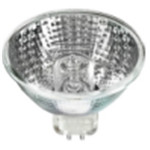Halogen Golbe Bulb are technically incandescent light bulbs -- illumination is produced in the two when a tungsten filament is heated sufficiently to emit light or "incandescence." The difference between the two is at the composition of the glass envelope and the gas inside the envelope. A normal incandescent bulb has a heat sensitive glass envelope that contains an inert gas mix, usually nitrogen-argon. After the tungsten filament is heated it melts and residue metal on the pine glass envelope (this is why incandescent bulbs look black at the end of life). This process demands incandescent bulb filaments to be warmed less than optimally to provide the bulb a sensible life. The lower filament temperature gives incandescent bulbs their normal orange-yellow, warm seeming light.
Halogen GLS incandescent bulb utilize a fused quartz counter ("capsule") allowing for higher temperatures. Inside the quartz envelope is a vapor, originally iodine, now generally bromine. The tungsten filament evaporates as usual but the higher temperatures are adequate to induce the tungsten to combine with the vapor instead of depositing on the envelope. Some of these evaporated tungsten is re-deposited about the filament. The combination of the "regenerative cycle" and higher filament temperature results in a bulb that has a longer lifetime and marginally higher efficacy than conventional incandescent bulbs. The higher temperature filament also produces the "white" light often connected with halogen bulbs.

